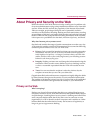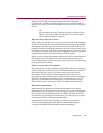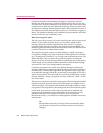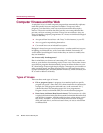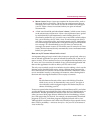
Internet Security and Privacy
104 McAfee Internet Security 5.0
Certificates are Microsoft technologies designed to guarantee a person’s
identity and Web site security. Personal certificates verify that you are who
you claim to be. Web site certificates verify that a Web site is secure and what
it claims to be (so Web sites can’t falsify their identity). When you open a Web
site that has a certificate, Internet Explorer checks if the certificate is correct. If
the certificate is not OK, Internet Explorer warns you. Certificates are great, in
theory. The problem is that they only establish a security standard—Web sites
are free to choose to use certificates, or not.
How does encryption work?
The only way to keep a secret is if you do not tell anyone, and if you do not jot
it down. If you need to share the secret, you can hide it within another
message, and let the intended recipient know how to find it. Computer
encryption hides messages by making the original data unintelligible. The
intent is to garble the data so that it can not be read. In this case, the data it self
is useless if access by an unintended recipient.
The simplest encryption systems use letter shifting, in which a message is
encrypted by shifting every letter n letters later in the alphabet. For example,
say A is changed to B, and B to C, etc. As long as the recipient knows how you
shifted the letters, they can easily decrypt the message by reversing the
process. Of course, a brute force approach to breaking this sort of encryption
would simply try all possible 26-letter combinations until the final message
was retrieved—not a very strong method of encryption.
Computer encryption uses a much more difficult technique of hiding the
message. Rather than a simple letter-shifting scheme, the original message is
transformed by a mathematical algorithm. The algorithm uses a secret “key”
to scramble the message, and the key is necessary to unscramble it. The key is
similar to a house key: The more teeth a key has, the more difficult it is to pick
the lock. Similarly, “strong” encryption uses keys with many “teeth”—in this
case, bits of data.
There are two commonly used levels of encryption. The international standard
is 40-bit encryption, but some sites in the United States use a higher level of
128-bit encryption. The number of bits indicates the length of the key used to
encrypt data. The longer the key, the stronger and more secure the encryption.
On the Web, your browser works with secure Web sites to establish and
manage the encryption that secures information. If your browser security
options include the Secure Sockets Layer (SSL), which ensures data
transmission privacy, you should turn on this option to facilitate secure data
transmission.
TIP
McAfee Internet Security’s Security Check automatically checks
your browser’s security level, and lets you know if you need to
change it.








